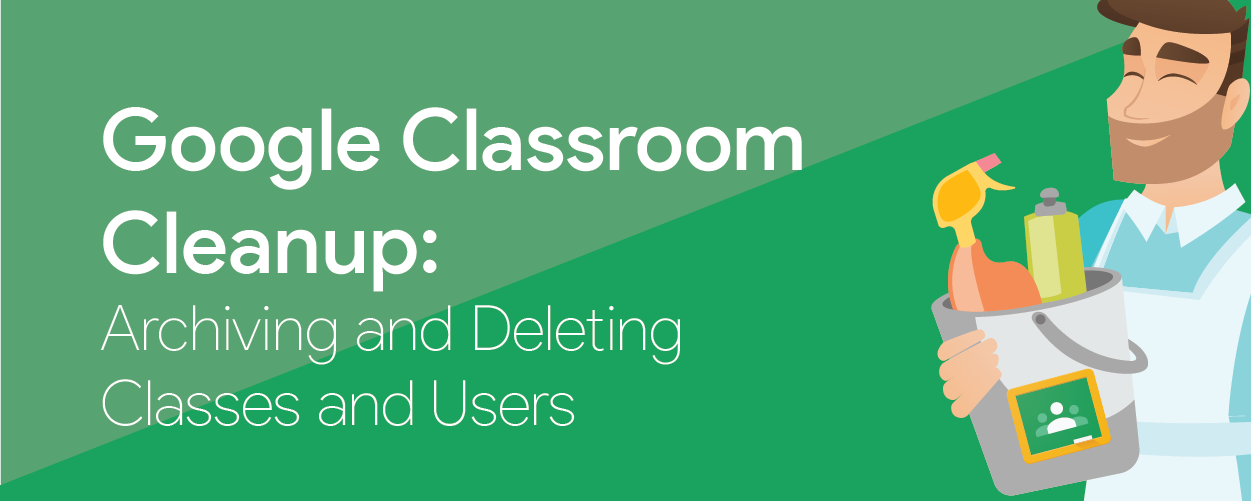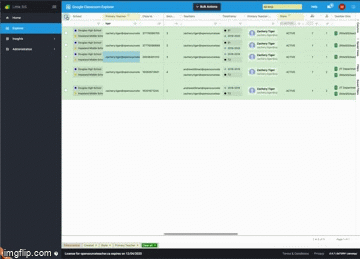 December 15, 2020
December 15, 2020
2020 has been a remarkable year for education. Moving from in-person instruction to remote learning is a huge change. You’ve taken amazing steps to ensure your students and teachers have uninterrupted learning. Congratulations on a job well done.
As the calendar year and semester are about to change, it’s time to look forward to next semester. Your teachers will want to begin the semester without old classes cluttering Google Classroom. To cleanup Classroom, you’ll archive their old classes and delete provisioned classes, if you have any. You’ll also delete user accounts of teachers who have left. Here’s a reminder, once a class ends, you can archive it. Deleting a class is a little different. You can’t revive deleted classes. You should only delete declined and provisioned classes.
Archiving and deleting classes one-by-one isn’t the best way to go about it. We’ve outlined the most efficient way for you to archive and delete classes. You’ll do this in a bulk action.
Let’s get started making sure Google Classroom is clean and organized. First, let’s review the differences between an archived and deleted class.
What happens to an archived class?
-
Archiving a class removes it from teachers’ and students’ Classroom homepage. The class moves to a separate area to preserve class materials, student work, and posts.
-
Teachers and students can still view an archived class. To use the class again, the teacher can restore it.
-
Teachers and students can access class materials for an archived class within the Google Drive folder.
-
Students can’t unenroll from an archived class.
-
Google Calendar retains the class calendar for teachers and students. Users can remove the calendar from view or permanently delete it.
-
An archived class stays in Google Classroom unless the primary teacher deletes it.
What happens to a deleted class?
-
Deleting a class removes it from Google Classroom. You can’t restore a deleted class.
-
Teachers and students can no longer access class posts or comments. Assignment grades are lost.
Timing your Google Classroom cleanup
Because of what happens to classes, the timing of your archive is important. You don’t want to archive or delete classes that are still in session. The best time to archive classes is after teachers have finished submitting grades for the semester.
Archiving classes In Google Classroom
In Google Classroom, teachers can individually archive their classes from the Classes page. They can restore these classes at any time and re-use class content in future classes.
Archiving classes using Little SIS
In Little SIS’ Classroom Explorer, you can perform a bulk archive across your domain, or for selected teachers. You’ll find this in the bulk actions drop-down at the top of the page. This opens the Bulk classroom cleanup wizard. The wizard helps you identify active classes by date, school, or teacher. Once you run the wizard, selected classes move from the homepage in Google Classroom. The classes move to the Archived classes section. You can opt to send the primary teacher an email when you run this action. It is your way to let them know they have an archived class.
Teachers can restore these classes and re-use class content in their new classes.

Archiving classes using GAM
If you’re a Google Apps Manager (GAM) user, you can download a list of all your classes using the print courses command. Then filter down to the list of classes you want to bulk archive. If you want to skip the filtering and return only active classes, use the print courses state active command. Next, you’ll use GAM to ingest this list. Finally, you’ll run the update course action to change the status of these classes to ARCHIVED. You can do this by course id or alias. You’ll want to reference the BulkOperations GAM wiki page for instructions on running this as a bulk task via CSV or Text file.
Deleting provisioned classes
There is no way to undo deleting a class. Be cautious when using this function.
As you create classes, with a synching solution or GAM, you may end up with provisioned classes on your domain. These classes are not active. Teachers never accepted them and there is no work assigned. Also, students can’t see provisioned classes on their homepage in Classroom. Since the semester has ended, provisioned classes are no longer needed. You don’t want to confuse teachers next year by showing them old classes in Google Classroom! The best course of action is to delete these classes.
Deleting provisioned classes using Little SIS
In Little SIS’ Classroom Explorer, you’ll run bulk delete classes. You’ll find this in the Bulk Actions drop-down at the top of the page. This opens the bulk classroom cleanup wizard. The wizard helps you identify active classes by date, school, or teacher. Once you run the wizard, selected classes no longer appear on the teachers’ Classroom home page.

Deleting provisioned classes using GAM
If you’re a Google Apps Manager (GAM) user, you can download a list of all your classes using the print courses command. Then filter down to the list of classes you want to bulk delete. If you want to skip the filtering and return only provisioned classes, use the print courses state active command. Next, you’ll use GAM to ingest this list. Finally, you’ll run the delete course action to remove the provisioned classes from the domain by class id or alias.
Transferring ownership before deleting users
As a part of your Classroom cleanup, you may want to remove user accounts. If a teacher has left and you don’t want to keep their account, you can delete it. There are some steps to take before you delete a user so you don’t end up with orphaned classes. An Orphaned class is one where a deleted user owns the class. Once you have an orphaned class, it is difficult (if not impossible) to remedy the situation.
Let’s look at a problematic scenario. If you delete a teacher account and there are students in the class they can still interact with each other. If the class lets students post to the stream, they can continue to post after deleting the teacher. Without a teacher, there is no one to supervise the interaction.
There are some simple steps you can take to avoid orphaning a class. First, transfer ownership of the class before you delete the teacher account. You can transfer these classes to a service account or another user in the domain. This could be the teacher taking over for the one who has left the district. Regardless, keep in mind that transferring ownership acts as an invitation. Only once the new teacher accepts the invitation should you delete the primary owner’s account.
Another option is to suspend rather than delete teacher accounts. With a suspended account, you can still transfer the classes they own to another user. Once transferred, the class retains the primary owner as a co-teacher in the Classroom. The new owner can later remove them.
Transferring classes using Little SIS
In the Little SIS Classroom Explorer, you can filter by the primary teacher. This is how you identify all active classes for the teacher account. Once you’ve located the classes, select them and use the Bulk Actions wizard to change the primary teacher. With Little SIS, you can opt to send messages to the former and new owner of the class. This is your way of alerting the former primary teacher of a transferred class. The new owner’s message prompts them to log in to Google Classroom and accept ownership. When active class ownership changes, the new owner becomes a co-teacher. They are co-teacher until the new owner accepts the invitation to take ownership of the class.

Transferring classes using GAM
If you’re a GAM user, you can change ownership of classes using the update course command. The same stipulations apply. The class must be active and currently owned by a non-deleted user on the domain.
About Little SIS and GAM
If you’re a newbie to GAM, feel free to take a stab at using it on your domain. The Getting Started Guide in GitHub is a great resource for new users. This is also where all the referenced commands in this article are located. GAM can do much more than Classroom management. It’s a great tool to have if you do bulk operations in G Suite. You must be a super admin to use GAM. You must also have to enable Google Cloud Platform to use the API commands.
Little SIS for Classroom is a paid tool from Amplified IT, but you can use it free for 30 days with a quote. You’ll have to be a super admin to get up and running with the tool. As a super admin, you can delegate the bulk actions to other users on your domain. Head on over to the Little SIS website to get a quote for your domain and start your trial. Take some time to visit our Help Center. It has the Getting Started Guide and knowledge base articles on Bulk Actions and more!
-

Melanie Long
Customer Success Lead -
About the Author:
Melanie lives in Virginia and is based in Amplified IT’s home office located in Norfolk. One of the first members to join the Amplified IT team, Melanie has worn many hats at the company. She most enjoys interfacing with customers and helping them implement tools that solve common pain points and frustrations. Today she leads the onboarding and interfacing with Labs tool clients, making lives easier and breezier one implementation at a time.

